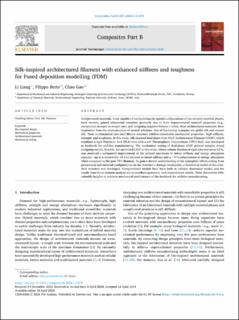| dc.description.abstract | Architectured materials, those capable of manipulating the spatial configurations of two or more material phases, have recently gained substantial attention, primarily due to their unprecedented material properties (e.g., exceptional strength-to-weight ratio and intriguing negative Poisson's ratio). Most architectured materials draw inspiration from the microstructure of natural solutions. One of fascinating examples are spider silk and cocoon silk. Their multimaterial core-shell fibrous structure exhibits remarkable mechanical properties—high stiffness, strength, and toughness. In this study, silk-inspired dual-phase Core-Shell Architectured Filament (CSAF), which combines a rigid Polylactic Acid (PLA) core with a soft Thermoplastic Polyurethane (TPU) shell, was developed as feedstock for additive manufacturing. The mechanical testing of dual-phase CASF printed samples reveal intriguing results. Notably, the optimized CASF in this study, whose volume fraction of rigid core was set as 52 %, was observed a substantial improvement of the printed specimens in initial stiffness and energy absorption capacity—up to a remarkable 14-fold increase in initial stiffness and a ∼9 % enhancement in energy absorption when compared to the pure TPU filament. To gain a deeper understanding of the synergistic effects arising from geometrical and material configurations on the structure's damage mechanism, a theoretical model of this core-shell structure was developed. Computational models have been built to validate theoretical model, and the results from finite element analysis are in excellent agreement with experimental results. These discoveries offer valuable insights to enhance mechanical performance of the feedstock for additive manufacturing. | en_US |

